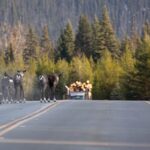Home »

Trench Society marks 20th anniversary
Twenty years ago eight grassroots organizations in the East Kootenay and upper Columbia Valley joined forces to initiate a ground-breaking program aimed at restoring grassland and open forest ecosystems in the southern Rocky Mountain Trench.
The coalition of hunters, ranchers, naturalists and environmentalists recognized that an ecosystem restoration program with a broad base of support was vital to sustain the region’s exceptionally rich diversity of plants and animals, and the people who depend on them.
Today the Rocky Mountain Trench Natural Resources Society – Trench Society for short – has 11 member organizations representing more than 4,000 people from Golden to Grasmere: Cranbrook Archery Club, Cranbrook Community Forest Society, East Kootenay Invasive Species Council, East Kootenay Wildlife Association, Kootenay Livestock Association, Rocky Mountain Naturalists, Southern Guides & Outfitters, The Land Conservancy, Waldo Stockbreeders, Wildsight and Windermere District Farmers Institute.
The society has sponsored a wide range of restoration initiatives since 1996 and is a key participant in the Rocky Mountain Trench Ecosystem Restoration Program, itself a partnership of more than 20 agencies restoring grasslands and open forests on Crown land, provincial and national parks, conservation properties and First Nations reserves. The program has become the model for similar ventures throughout B.C.
“The Trench Society’s achievements over the past 20 years are remarkable,” said Chair Robyn Duncan, who represents Wildsight on the society’s board. “The diversity of partners at the table is the key to our success.
“A common concern for healthy ecosystems brought us together and the ongoing need for restoration keeps us going.”
Directors, staff and guests celebrated the 20th anniversary with a field tour of recent restoration projects at the Wycliffe wildlife corridor between Cranbrook and Kimberley and in the Lakit-Brewery Ridge area east of Fort Steele.
Partners in the restoration program have so far returned more than 20,000 hectares (50,000 acres) to historical grassland and open forest condition by removing dense forest ingrowth, and often following up with prescribed burning.
These restoration treatments produce a multitude of benefits: healthier and more productive native plant communities, better grazing for domestic livestock and wild ungulates, habitat for many at-risk species, forests less susceptible to disease and insect attack, reduced forest fuels and lower wildfire hazard, and ecosystems that are more resilient to a changing climate.
Significant funders since the restoration program began in 1998 include the BC and federal governments, Columbia Basin Trust, First Nations Emergency Services Society, Fish and Wildlife Compensation Program and Habitat Conservation Trust Foundation.
Visit www.trench-er.com for more information on ecosystem restoration in the Rocky Mountain Trench.
Above photo: Trench Society directors, staff and guests at the Lakit Face restoration project east of Fort Steele, two months after a prescribed burn by the BC Wildfire Service. The Lakit project, and a similar project on nearby Brewery Ridge, enhanced habitat for bighorn sheep, elk and mule deer. Back row: Bob Bjorn, Wycliffe; Mark Hall, Jaffray; Robyn Duncan, Kimberley; Rick Tegart, Radium Hot Springs; Gordon Edwards, Jaffray; Eddie Petryshen, Bull River; Don Lancaster, Mayook; Dan Murphy, Cranbrook. In front: Susan Bond, Kimberley; Grant Griffin, Cranbrook; Glynn Killins, Kimberley. (Mike Morrow photo)
Rocky Mountain Trench Natural Resources Society







